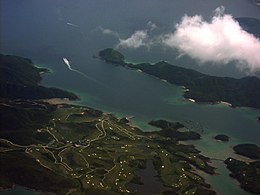Kau Sai Chau
| 滘西洲 | |
|---|---|

Kau Sai Chau and its golf course. Yim Tin Tsai and the breakwater are visible at the bottom right. The island at the centre right is Sharp Island.
|
|
| Location of Kau Sai Chau within Hong Kong | |
| Geography | |
| Location | Sai Kung |
| Area | 6.70 km2 (2.59 sq mi) |
| Administration | |
| Kau Sai Chau | |||||||||
| Traditional Chinese | 滘西洲 | ||||||||
|---|---|---|---|---|---|---|---|---|---|
|
|||||||||
| Transcriptions | |
|---|---|
| Yue: Cantonese | |
| Yale Romanization | Gaau sāi jāu |
| Jyutping | Gaau3 sai1 zau1 |
Kau Sai Chau (Chinese: 滘西洲) is an island located off the coast of Sai Kung of Hong Kong, with an area of 6.70 km², making it the 6th largest island of Hong Kong. It is under the administration of Sai Kung District.
Kau Sai Chau is located south of the Sai Kung Peninsula. Its northern shore forms part of the southern limit of Port Shelter, of which it is the largest island. Kau Sai Chau is connected in the north by a breakwater to the smaller island Yim Tin Tsai. The southern tip of the island is separated by a narrow channel from Jin Island. It has a maximum elevation of 216 m.
The Jockey Club Kau Sai Chau Public Golf Course, developed and run by the Hong Kong Jockey Club, is the only public golf course in Hong Kong. Opened in 1995, it occupies approximately the northern half of the island. It comprises three 18-hole golf courses: the North and South Courses were designed by Gary Player, while Nelson & Haworth designed the East Course.
Kau Sai Village is a small fishing hamlet with about ten houses. It is located at the southern tip of the island.
Two declared monuments of Hong Kong are located on Kau Sai Chau: a prehistoric rock carving and a Hung Shing Temple:
The prehistoric rock carving was discovered in 1976. It is located on the north-western coast of the island, in a location "where accessibility by land is extremely poor".
The Hung Shing Temple is located in the southern part of the island, near Kau Sai Village, of which it is the only temple. The building was built before 1889. It is constructed in grey bricks with a timber roof frame. The temple has been renovated four times, in 1949, in the 1970s, in 1988 and the last being from August 1999 to February 2000. The restoration was declared an "Outstanding Project" by the UNESCO Asia-Pacific Heritage 2000 Awards. Previously a Grade III Historic Building, the temple was declared a monument on November 15, 2002. The Hung Shing Festival (洪聖誕) is celebrated there on the 13th day of the 2nd month in Chinese calendar.
...
Wikipedia

